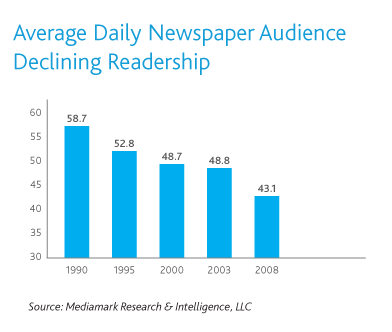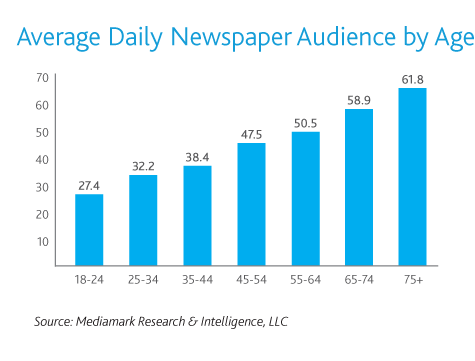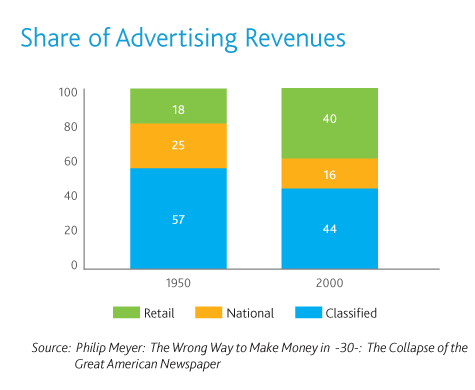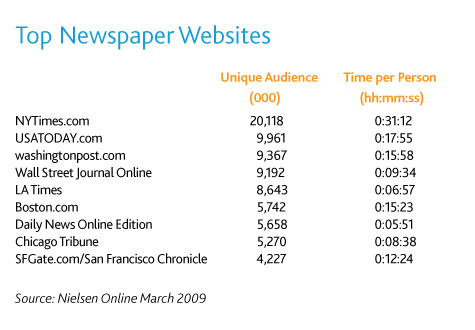Doug Anderson, SVP, Research & Development, The Nielsen Company
SUMMARY: Bankruptcies, declining readership, falling ad dollars and the suburbanization of America have all contributed to the slow death of the great American newspaper. Hope for a resurgence of the printed newspaper seems like a pipe dream. However, with the Internet, there is an opportunity to reclaim immediate coverage of breaking stories. Can the technology that has so hurt them also come to the rescue of the big city newspaper?
Newspaper closings have become so commonplace in the first quarter of 2009 that it’s difficult even to compile a full list. The Rocky Mountain News closed entirely two months before its 150 year anniversary. The Seattle Post-Intelligencer and the Christian Science Monitor moved entirely online. Others, like the Detroit News and the Detroit Free Press, have begun new distribution models that do not offer home delivery four days of each week. And many others are already in bankruptcy or are sitting at the door, including the Los Angeles Times, the Chicago Tribune, the Baltimore Sun, the Minneapolis Star Tribune, the Philadelphia Inquirer and Philadelphia Daily News, and the San Francisco Chronicle.
| All struggled and failed to get out from under leveraged buyouts… |
For the larger conglomerates, the pattern is the same. When it declared bankruptcy at the end of 2008, the Tribune Company had assets of some $7.6 billion, but debts—most stemming from when the company was purchased through a leveraged buyout and taken private a year earlier—of around $13 billion. Star Tribune Holdings, the Journal Register Company, and Philadelphia Newspapers LLC have all struggled and failed to get out from under leveraged buyouts by individuals and venture capital consortiums and are in bankruptcy today.
In 1950, nearly every adult in the United States read a daily newspaper. By 1976, newspaper circulation was around 60 million, but spread across 73 million households. Prior to the latest round of newspaper closings, total circulation was down a few million from the 1976 level, but the household count of the U.S. had grown to over 118 million. Readership penetration has been below 50% for more than a decade and continues to fall.

| Readership penetration has been below 50% for more than a decade… |
Hope for a resurgence of the printed newspaper seems like a pipe dream. Readership is lowest for younger adults and increases with age. As these younger adults age, newspaper reading will soon fall to unsustainable levels. To make matters worse, the youngest age ranges are those for which readership levels fell the most from 2003 to 2008. Total daily newspaper audiences fell by 12% from 2003 to 2008, but readership levels in the 18–24 age range fell by over 20%. On the other end of the distribution, 62% of those over the age of 75 still read a daily newspaper.

Declines in audience have led to pressures on the advertising dollars that make newspaper publication possible (subscriptions and single copy prices cover only a fraction of the cost of production—about 18% of revenues on average, while advertising makes up the other 82%). After a couple of years of moderate growth, advertising dollars for national newspapers have fallen for two consecutive years and are currently below 2004 levels. Advertising revenues dropped by nearly 10% from 2007 to 2008 according to Nielsen.
Where have all the newspapers gone?
Besides the emergence of the Internet, probably the biggest shift in the newspaper business since 1950 has been in the form of ownership. In the 1950s, the vast majority of newspapers were local, family-owned businesses. Even the larger newspapers were privately held by giants of the industry like Hearst, McCormick, Pulitzer, and Knight, who have long since passed into legend.
| Besides the Internet, the biggest shift in the newspaper business has been in the form of ownership… |
When newspapers flourished and began to run with record profits, they attracted the attention of the IRS. New tax rules changed the way in which newspapers were valued for tax purposes. Many families had to sell in order to get out from under the new tax burdens and the era of the newspaper conglomerate was born, as smaller papers were snapped up into large groups like Gannett, Knight-Ridder, and the Tribune Company.
With public ownership, new pressures came from Wall Street, most notably the need to show strong and sustained profit growth—something the newspaper business had never been good at. Demands for growth led to round after round of cost cutting, particularly within the editorial staffs, which, arguably, led to a poorer quality product with less universal relevance, leading to more declines in readership, to further declines in ad revenues, and more cost cutting.
Advertising redefined
The marketplace in which newspapers compete has radically changed. The share of advertising revenues coming from classified advertising grew substantially from 1950 to 2000, from 18% to 40%. National advertisers—never a huge part of revenues—lowered their investment in newspapers. Consolidations and the closing of many of the large department store chains also forced revenues down. Walmart—which has filled some of the gap left by the decline of the large department store chains in the marketplace—has never been a particularly strong newspaper advertiser.

Unfortunately, the 1990s and 2000s proved to be exactly the wrong time for newspapers to increase their reliance on classified advertising. The three pillars of the classifieds—job, autos, and real estate—have been areas of tremendous growth on the Internet. Craigslist, Monster, and a long list of other Internet sites that have become household names that redefined the classified ad and stripped revenues from newspapers. Spending on coupons has continued to grow (up 17% from 2000 to 2005), but has not nearly been enough to offset the loss of classified advertising.
| Internet sites have stripped revenues from newspapers… |
The suburbanization of America
Long-term demographic factors have also greatly contributed to the decline of newspapers in the U.S., perhaps none so much as the suburbanization of America that began after World War II. The largest and most powerful newspapers were the big city dailies. They had large staffs of reporters and editors all focused on what was going on in the city. As households moved from the cities to the suburbs, the editorial focus of the newspaper didn’t follow them. For example, the Philadelphia Inquirer was a city paper, but today has two-thirds of its readers in the suburbs. Most coverage is still concentrated in the city and the newspaper struggles to put enough feet on the ground to cover a far-ranging suburban sprawl with scores of municipalities (and many competing suburban newspapers).
The future of newspapers
The day of the printed newspaper may be almost gone. Readership levels among younger persons would have to more than double to provide enough audience to sustain the big papers, and that would require reversing a declining trend that has been ongoing for decades.
| Can the technology that hurt them also come to the rescue? |
Newspapers have been described as delivering “What happened today that didn’t happen yesterday, dressed up and delivered tomorrow”. For many years, getting a summary of what happened yesterday today was good enough. Today, news is what happened ten minutes ago and is still going on. With the large scale adoption of radio in the middle of the 20th century, newspapers lost their claim to immediacy. With the Internet, though, they have the opportunity to reclaim immediate coverage of breaking stories. But can the technology that has so hurt them also come to the rescue of the big city newspaper?
Most large newspapers have extensive Internet websites providing much if not all of the content found in the printed editions. Many are free but some are experimenting with a pay service. Many sites are doing quite well, both in terms of readership and advertising revenues. The table below shows newspaper websites with unique audience levels above four million in March 2009. Advertising revenues for newspaper websites have been growing by over 30% per year for some papers in recent years, but they are still a small fraction of the revenues from the printed editions.

Mobile web access may ultimately save at least some newspapers. Amazon just released the Kindle DX, a larger format version of the popular Kindle which offers daily downloads of the entire printed edition of many newspapers. Others—including some of the newspaper groups themselves—are looking into building their own hardware and selling directly to readers. How it all shakes out is anyone’s guess, but for the first time in quite some time, there is at least some hope that the great American newspaper will have a life long after paper versions have disappeared.
Sources:
-30-:The Collapse of the Great American Newspaper, Charles Madigan Editor
Mediamark Research & Intelligence
The Nielsen Company: Nielsen Online, Nielsen Media Research



